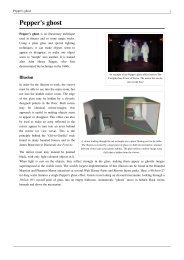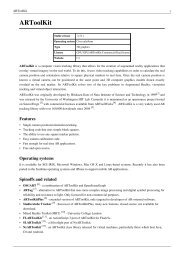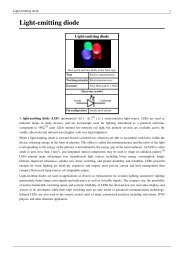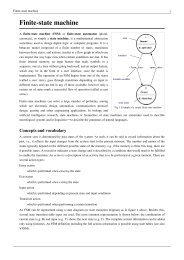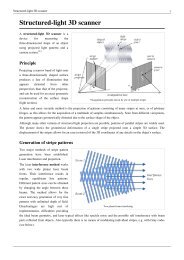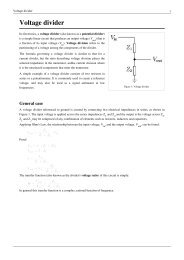3D scanner - Wikipedia, the free encyclopedia.pdf - Ex-ch.com
3D scanner - Wikipedia, the free encyclopedia.pdf - Ex-ch.com
3D scanner - Wikipedia, the free encyclopedia.pdf - Ex-ch.com
Create successful ePaper yourself
Turn your PDF publications into a flip-book with our unique Google optimized e-Paper software.
<strong>3D</strong> <strong>scanner</strong> 10<br />
Cuneiform tablets<br />
In 2003, Subodh Kumar, et al. undertook <strong>the</strong> <strong>3D</strong> scanning of ancient cuneiform tablets. [15] Again, a laser<br />
triangulation <strong>scanner</strong> was used. The tablets were scanned on a regular grid pattern at a resolution of 0.025 mm.<br />
Kasubi Tombs<br />
A 2009 CyArk <strong>3D</strong> scanning project at Uganda's historic Kasubi<br />
Tombs, a UNESCO World Heritage Site, using a Leica HDS 4500,<br />
produced detailed ar<strong>ch</strong>itectural models of Muzibu Azaala Mpanga, <strong>the</strong><br />
main building at <strong>the</strong> <strong>com</strong>plex and tomb of <strong>the</strong> Kabakas (Kings) of<br />
Uganda. A fire on Mar<strong>ch</strong> 16, 2010, burned down mu<strong>ch</strong> of <strong>the</strong> Muzibu<br />
Azaala Mpanga structure, and reconstruction work is likely to lean<br />
heavily upon <strong>the</strong> dataset produced by <strong>the</strong> <strong>3D</strong> scan mission. [16]<br />
“Plastico di Roma antica”<br />
In 2005, Gabriele Guidi, et al. scanned <strong>the</strong> “Plastico di Roma<br />
antica”, [17] a model of Rome created in <strong>the</strong> last century. Nei<strong>the</strong>r <strong>the</strong><br />
triangulation method, nor <strong>the</strong> time of flight method satisfied <strong>the</strong><br />
Photo overlaid atop laser scan data from a project<br />
held in early 2009 at Uganda's Kasubi Tombs,<br />
whi<strong>ch</strong> were destroyed by fire in early 2010; <strong>the</strong><br />
data is slated for use in <strong>the</strong> building's<br />
reconstruction.<br />
requirements of this project because <strong>the</strong> item to be scanned was both large and contained small details. They found<br />
though, that a modulated light <strong>scanner</strong> was able to provide both <strong>the</strong> ability to scan an object <strong>the</strong> size of <strong>the</strong> model and<br />
<strong>the</strong> accuracy that was needed. The modulated light <strong>scanner</strong> was supplemented by a triangulation <strong>scanner</strong> whi<strong>ch</strong> was<br />
used to scan some parts of <strong>the</strong> model.<br />
Medical CAD/CAM<br />
<strong>3D</strong> <strong>scanner</strong>s are used in order to capture <strong>the</strong> <strong>3D</strong> shape of a patient in orthotics and dentistry. It gradually supplants<br />
tedious plaster cast. CAD/CAM software are <strong>the</strong>n used to design and manufacture <strong>the</strong> orthosis, pros<strong>the</strong>sis or dental<br />
implants.<br />
Many Chairside dental CAD/CAM systems and Dental Laboratory CAD/CAM systems use <strong>3D</strong> Scanner te<strong>ch</strong>nologies<br />
to capture <strong>the</strong> <strong>3D</strong> surface of a dental preparation (ei<strong>the</strong>r in vivo or in vitro), in order to produce a restoration digitally<br />
using CAD software and ultimately produce <strong>the</strong> final restoration using a CAM te<strong>ch</strong>nology (su<strong>ch</strong> as a CNC milling<br />
ma<strong>ch</strong>ine, or <strong>3D</strong> printer). The <strong>ch</strong>airside systems are designed to facilitate <strong>the</strong> <strong>3D</strong> scanning of a preparation in vivo and<br />
produce <strong>the</strong> restoration (su<strong>ch</strong> as a Crown, Onlay, Inlay or Veneer).<br />
Quality Assurance / Industrial Metrology<br />
The digitalization of real-world objects is of vital importance in various application domains. This method is<br />
especially applied in industrial quality assurance to measure <strong>the</strong> geometric dimension accuracy. Industrial processes<br />
su<strong>ch</strong> as assembly are <strong>com</strong>plex, highly automated and typically based on CAD (Computer Aided Design) data. The<br />
problem is that <strong>the</strong> same degree of automation is also required for quality assurance. It is, for example, a very<br />
<strong>com</strong>plex task to assemble a modern car, since it consists of many parts that must fit toge<strong>the</strong>r at <strong>the</strong> very end of <strong>the</strong><br />
production line. The optimal performance of this process is guaranteed by quality assurance systems. Especially <strong>the</strong><br />
geometry of <strong>the</strong> metal parts must be <strong>ch</strong>ecked in order to assure that <strong>the</strong>y have <strong>the</strong> correct dimensions, fit toge<strong>the</strong>r and<br />
finally work reliably.<br />
Within highly automated processes, <strong>the</strong> resulting geometric measures are transferred to ma<strong>ch</strong>ines that manufacture<br />
<strong>the</strong> desired objects. Due to me<strong>ch</strong>anical uncertainties and abrasions, <strong>the</strong> result may differ from its digital nominal. In<br />
order to automatically capture and evaluate <strong>the</strong>se deviations, <strong>the</strong> manufactured part must be digitized as well. For<br />
this purpose, <strong>3D</strong> <strong>scanner</strong>s are applied to generate point samples from <strong>the</strong> object’s surface whi<strong>ch</strong> are finally <strong>com</strong>pared









